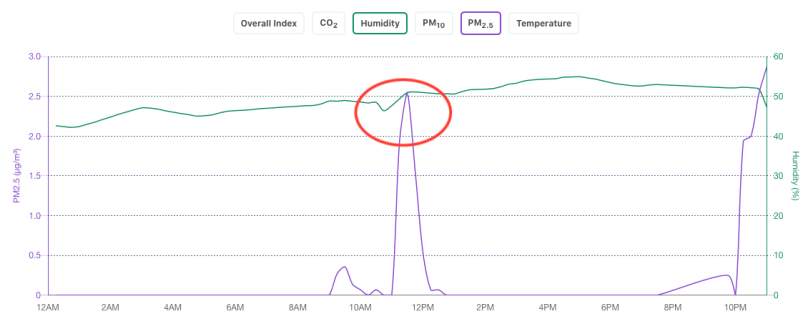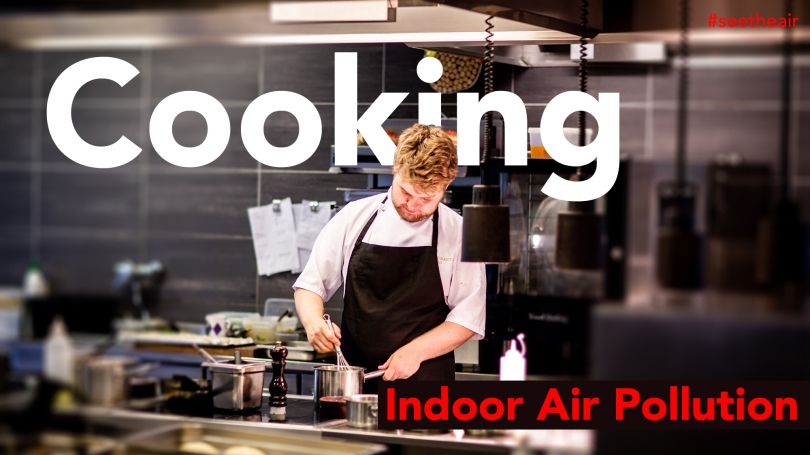I am sure you all have heard that we spend 90% of our time indoors, as a result we have to create a healthy environment if we want to stay healthy and strong. Although I am very tired of hearing this expression, it is true, most of us spend that 90% indoors but not only inside our house. Inside our houses we spend about 60% of our time, cooking, cleaning, sleeping/resting, having fun with our loved ones and reading.
In this experiment, I want to demonstrate what academic studies have already proved that when we cook we deteriorate the air quality inside our house. Remember we eat at least twice a day and probably we have to cook twice a day as well.
I have cooked and measured various parameters with three air quality monitors – just for confirmation – for 3 very common foods (at least in my opinion). Homemade Baked Bread, Chicken Curry and Boiled Vegetables (Broccoli/Cauliflower/Carrots).
First Food – Bread

The formaldehyde sensor has detected high formaldehyde CH2O concentrations during the baking process of the bread which most likely happened because flour particles where accidentally deposited on top of the resistor coil which reaches a temperature of about 230°C. We know that when organic material, like wood, burns then CH2O is the first chemical that is released into the atmosphere. In the case of wood-burning –in wildfires or fireplaces– CH2O is converted to something else immediately after because temperatures are higher than 260°C. In the case of the bread baking, the temperature was not high enough for the CH2O to be converted into something else. There was hardly any increase in other pollutants.
Second Food – Chicken Curry

Here the story is different. Both particulate matter and VOC sensors measured a high concentration of pollutants. The PM concentrations were high because of the frying process of the chicken, veggies and spices on the frying pan and its reaction with water. Oil and water don’t mix well as a result, the oil and other lipids from the food explode and are released into the atmosphere in the form of an aerosol. For the same reason, a lot of VOCs are released into the indoor environment. I was able to recover the air quality rapidly after the food was cooked thanks to ventilation and because I had the windows open in the kitchen.
Third Food – Vegetables

Basically, boiling veggies is the safest way to eat. Air quality wasn’t affected at all. There was only some small increase in humidity in the kitchen room from the evaporated water, for the same reason the PM2.5 sensor registered the same increase but the measured particles ware only H2O droplets. The pot lid can condensate most of the evaporated water but some of it escapes.
Conclusion
All in all, cooking air pollution is real most of the time. We can improve our health by taking precautions when we cook, like using a pot lid, an extractor hood and keep windows open.
Discover more from See The Air
Subscribe to get the latest posts to your email.


No discussion of CO2? In the temporary flat we’re staying in we will often see CO2 rise above 1500ppm (based on IQAir) when we’re cooking and then it takes 2-3 hours to get back below 1000.
This is partly caused by poor ventilation and very limited fresh air intake to the flat along with a recirculating range hood rather than one that exhausts effluent to the outside.
Is this purely byproducts of using natural gas or something else causing such a significant rise?
LikeLiked by 1 person
CO2 is a byproduct of the combustion process or breathing. If you don’t a ventilation system then keep a window open of possible. In my house I don’t have mechanical ventilation (broken at the moment) so I try to keep windows open when possible.
1000ppm is still high. What’s the average daily CO2 concentration in your apartment?
LikeLiked by 1 person
Daily average is 873ppm which is higher than I’d like and over 1000 at night in our bedroom is not unusual. I’d prefer it never go above 700 and average closer to 550. Interestingly this is a new less than 1 year old building and yet such poor IAQ.
Our new house is averaging 428ppm but we’ve not yet moved in so it will be interesting to see how it does with people sleeping there and not as many people going in/out during the day.
LikeLiked by 1 person
New buildings that offer better and more modern insulation but lack a ventilation system have this common problem.
My apartment has this problem too so by opening two windows on the opposite walls, lets say my bedroom is in north and my kitchen is in south, I can refresh the air much faster aka cross ventilation.
LikeLiked by 1 person
For the same reason, a lot of VOCs are released into the indoor environment. I was able to recover the air quality rapidly after the food was cooked thanks to ventilation and because I had the windows open in the kitchen.David Brown famous for delicious smoker recipes, expert cooking methods, cooking tips, and tricks as well as for his cooking recipes.
LikeLike